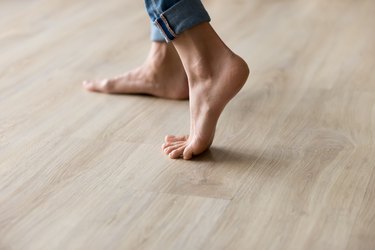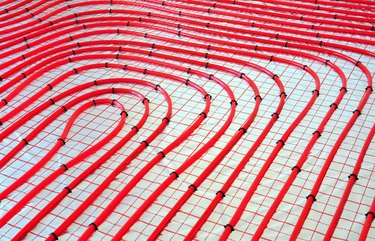
If you're wondering whether radiant floor heating systems are more efficient than forced-air heating systems, the answer is almost always yes provided the discussion is about hydronic (hot water) radiant heating and not electric. According to a study from Kansas State University, hydronic radiant floor heating is typically 25 percent more efficient than other forms of home heating, including forced air, and there are several reasons for this. In fact, by making the right installation choices and running a hydronic system with energy savings in mind, homeowners can increase the efficiency even further.
Electric radiant floor heating systems provide the same type of comfortable heat as hydronic systems, but electricity is expensive and ultimately less efficient than heating water with a gas boiler. Also, an electric radiant floor often doesn't get hot enough to heat an entire room, so its best application is for warming floors in particular parts of the house, and you often need a supplemental heat source. A hydronic floor heating system, on the other hand, provides whole-house heating, so if you're thinking of alternatives to furnaces and heat pumps, it's the better candidate.
Video of the Day
Video of the Day
The monthly home heating savings you can realize by a 25 percent increase in efficiency can be significant; it's the difference between $480 and $600 monthly heating bills. However, the upfront costs of installing hydronic radiant floor heating are considerably more than those for installing a furnace or heat pump, assuming your house already has the necessary ductwork. If you're in the middle of new construction or a renovation project, however, and you haven't installed ductwork, you're in a perfect position to take advantage of the benefits of hot-water-heated floors, including higher energy efficiency.
Tip
Radiant floor heating is 25 percent more efficient than forced air, and there are ways to make it even more efficient than that.
Radiant Floor Heating vs. Forced Air
A forced-air heating system employs either a furnace or heat pump to heat air and circulate it throughout the building through a ductwork system. A not-insignificant portion of this heated air gets lost through leaks in the ductwork, and the warm air that exits the registers tends to rise to the ceiling, where even more is lost through gaps in the home's structure. People tend to spend most of their time on the floor, not the ceiling, so their heads feel warmer than their feet, which is not an ideal situation for those who like to traipse around the house in bare feet.
By comparison, water can transport 3,500 times more energy than air, which means that much more energy generated by the heat source is available for heating. None of the energy is lost through leaky ductwork, and because it radiates from the floor upward, much less is wasted through structural gaps in the building, and people's feet feel warmer than their heads. Moreover, the entire room is heated uniformly, so there are no cold spots. All in all, homeowners are able to feel comfortable with lower thermostat settings, which can make a big difference in energy savings.
In terms of air quality and comfort, radiant systems are cleaner and quieter than forced-air systems. Even though HVAC systems have filters, they still tend to circulate and recirculate pollutants and allergens, particularly if the filters don't get changed regularly, and HVAC equipment is noisy. In-floor radiant heat systems do not circulate allergens, they are quiet and — added bonus — they require no maintenance other than that needed to keep the boiler running smoothly.

Radiant Floor Heating vs. Other Alternatives
Radiant heat systems don't have to be installed in the floor; in fact, many vintage homes have hydronic radiators or hydronic baseboard systems. These radiant heaters — as well as electric ones — don't broadcast warm air uniformly, so there are bound to be cold spots in the room, and homeowners often compensate by turning up the thermostat. This strategy uses more energy and results in excessively warm air around the heating elements to the point at which it may be necessary to erect barriers to keep children and pets away.
As radiators, baseboard heaters and other radiant elements heat up, convection currents carry the hot air toward the ceiling and the result is much the same as what happens with a forced-air system. The room is warmer near the ceiling than it is near the floor, and your feet feel cold unless you happen to be standing near one of the heating elements. To take advantage of the uneven heating, it's often necessary to arrange furniture close to the heating elements, leaving the colder parts of the room unused. In a room heated with radiant floor heating, the heat is distributed uniformly, so furniture can be arranged according to design preferences and not as a strategy to keep people warm.
WarmlyYours claims that radiant floor heating is 100 percent efficient because there is no way for heat to be lost, and that means you never have to overheat, which can increase fuel costs by 8 percent. Radiant floor heating is usually installed with a manifold that splits the main line from the boiler into zones that serve individual rooms, and this is another energy-saving benefit. Each zone can have its own thermostat, allowing homeowners to selectively heat the parts of the house they use the most instead of having to heat the entire house to the same temperature. This is a cost-effective bonus for a small family occupying a large house or for people who spend most of their time in specific areas, such as the living room, bedroom and kitchen.
Optimizing Radiant Floor Heating Efficiency
The type of floor covering you use for radiant floor heating systems has a direct bearing on heating efficiency. Stone and ceramic tile as well as a concrete floor are able to absorb heat and store it, and you can take advantage of the stored heat by using a programmable thermostat and a floor sensor. You switch on the heat at intervals during the day to charge the floor with heat and then switch it off again to allow the heat to radiate from the floor material. This cycle, which is similar to that for an oil-filled electric radiator, keeps the room comfortable while preventing the floor from becoming "stone cold" and requiring extra heat to warm it up again. Once you learn the heating characteristics of the floor by experience, you can calculate the thermostat program for the most effective heating cycle.
Laminate and vinyl are also good heat conductors, but you want to stay away from insulators like heavy-pile carpets, which can absorb heat but don't radiate much. If you must use carpet, it should be as dense as possible, and the pile should be no more than 3/4 inch with an additional 1/4-inch underlayment. Installing radiant heat under carpeting may work in a small room that is tightly insulated, but it isn't recommended for drafty hallways or rooms with high ceilings.
To save energy, it's important to prevent heat loss through the underside of the floor, and there are several strategies to employ. When embedding PEX heating pipes in a concrete slab, it's common to install a reflective underlayment under the slab, and when embedding the pipes in a layer of concrete on top of a slab, the underlayment typically goes between the concrete and the existing slab. When installing radiant heating pipes underneath a subfloor by threading them through holes in the joists, there should always be a radiant barrier attached to the underside of the joists. The barrier makes the installation more cost-effective by maximizing the amount of heat that comes into the room through the floor and reducing the temperature needed for effective heating, which means you need to use less energy to stay comfortable.
- Energy.gov: Radiant Heating
- Plumbing & Mechanical: 4 Reasons Hydronic Radiant Heating Promotes Sustainability and Indoor Environmental Quality
- WarmlyYours: How to Maximize Electric Radiant Floor Heating Energy Efficiency
- WarmlyYours: Comparing Radiant Floor Heating with Baseboard Heating
- Warmup: Heated Floors vs. Radiators – The Key Differences
